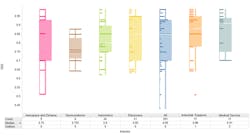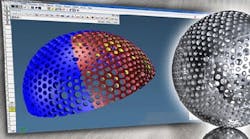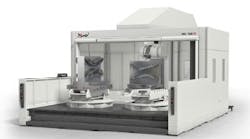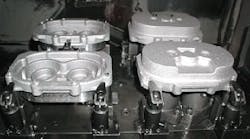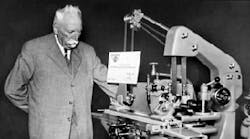By Jim Benesi Associate Editor
Advanced Technology Services uses its CMMS to generate a factory map that provides a quick, visual indication, with various colors, of the status and availability of machines in a shop.
The perception of maintenance is changing with forward-looking shops that appreciate the crucial contribution it makes to their success. These shops view maintenance as the way to keep machines and equipment running, rather than as a way to fix things when they break. Proactive and predictive techniques allow for spotting and eliminating potential problems before they cause a breakdown.
On the other hand, many shops see the job of keeping critical production lines running to consistently satisfy customer delivery requirements as an exercise in frustration. These shops frequently are faced with time-consuming, emergency machine breakdowns or performance-robbing deviations that ruin their best efforts to meet production schedules. And their maintenance crews often flit from one problem to the next only to find that they lack the tools, parts and, perhaps, the skills to get the errant machine or equipment up and running immediately. If manufacturers are to be successful in coping with today’s demanding global market conditions, they have to eliminate reactive maintenance practices and become more proactive. That ensures optimal machine availability.
The problem is that maintenance is not considered a core competency for most manufacturing firms, so it does not get the resources that are necessary to develop and maintain an effective maintenance management program.
Core competencies are supplier differentiators — they are the reasons customers buy a company’s products. With most manufacturing companies, core competencies might include production, engineering, distribution or customer service. Much of the time, production-equipment maintenance is treated like payroll, accounts receivable, human resources, janitorial and security services. It does not make the list of core competencies for shops, even though machine availability is critical to their production success.
To cope with market challenges, manufacturers must lower operating costs, develop more efficient processes, achieve greater profitability and sustain long-term stability. Even though shops might implement strategies such as lean manufacturing and Six Sigma to cut costs, without a proactive, predictive maintenance program they undermine their ability to sustain successful production schedules.
Small and mid-size shops are hard pressed to devote the resources necessary to develop a proactive, predictive production- maintenance program to ensure stable and reliable processes that meet challenging delivery requirements.
Increasingly, manufacturers are outsourcing production maintenance to firms that make asset management their core competency. These firms offer computerized machine monitoring and data analysis, sophisticated test equipment, effective spare-part inventory control and trained maintenance specialists. Maintenance providers usually begin with an assessment of a customer’s production needs and forecasts, and then develop a specific action plan to meet these requirements.
Essential elements The key to developing an effective production-asset maintenance program is to address all of its essential elements: Personnel, maintenance leadership, procurement and management of supplies, tools and technology. These elements are intertwined, and failure to address all of them could weaken the entire program. Few shops have the necessary personnel and financial resources to address all of these issues successfully on their own.
Employees that have specialized maintenance training are rare.
“The most common maintenance problem encountered by shops is a lack of skilled personnel,” said Vlad Bacalu, product manager at Advanced Technology Services Inc. (www.advancedtech.com). “The pool of experienced maintenance personnel is shrinking due to the retirement of skilled technicians, and most shops find it difficult to replace them. Most apprentice programs have been scuttled, and few young people view maintenance as a desirable career path.”
However, firms that specialize in asset management have the resources to train maintenance personnel in the latest technologies and techniques. These specialists, who work on-site at a customer’s location, have access to a broad spectrum of challenges and best-practice solutions. They are specialized and have abilities specific to the production environment of the shop in which they work. They also provide the maintenance leadership that is necessary to guide the effort to transition to a proactive approach from a reactive approach by focusing on the results of their work.
Procurement and management of spare parts and maintenance supplies is difficult and expensive for most shops.
Supplies and spare parts can account for as much as 60 percent of maintenance spending, so an effective plan must be in place to reduce the cost and number of inventoried parts.
The tools and technologies of effective maintenance are focused on predicting and forecasting maintenance needs. A proactive approach to maintenance can help a shop avoid catastrophic breakdowns and the issues of too much downtime, overtime, replacement part expense, poor product quality, missed deadlines and lost business that can follow such catastrophes.
Metrics for success The key to effective proactive and predictive maintenance is to establish a system to collect data that is relevant to maintenance performance, then monitor and analyze that data to spot potential problems before they happen.
As Bacalu put it: “If you don’t measure it, you can’t improve it.”
Advanced Technology Services uses a customized Computerized Maintenance Management System (CMMS) to track key performance indicators as a measure of the effectiveness of maintenance activities in support of a customer’s strategic goals. The metrics include mean time between failure, mean time to repair, equipment availability and downtime hours.
If, for example, a shop’s goal is to increase the level of preventive maintenance, then the man-hours spent doing preventive maintenance should be tracked. Other key performance indicators that support this goal include proactive versus reactive man-hours, number of reactive maintenance calls, maintenance overtime hours and work order backlog levels.
When repetitive equipment problems begin to occur, a root cause analysis identifies the cause so corrective action can be taken before a breakdown occurs. Several techniques are used:
Vibration analysis is used with rotating equipment to pinpoint the cause and severity of vibrations caused by unbalances, such as those generated by defective bearings, misalignment and bent shafts.
Oil analysis detects metal particles or other tramp materials in an oil sample and indicates the source of the problem. Oil analysis, coupled with vibration analysis, is an especially useful diagnostic tool for rotating equipment.
Thermography, or infrared scanning, provides an early warning of hazardous conditions caused by thermal anomalies. These can be caused by faulty wiring, loose electrical connections, corrosion, wet or damaged insulation, refractory breakdown and faulty seals.
Ultrasound is a sensitive technology that detects upper range acoustic frequencies inaudible to the human ear. It often is used to inspect compressors, valves, heat exchangers, steam traps, boilers and condensers for gas and steam leaks, electrical discharges such as arcing, tracking and corona, and to identify bearing faults.



